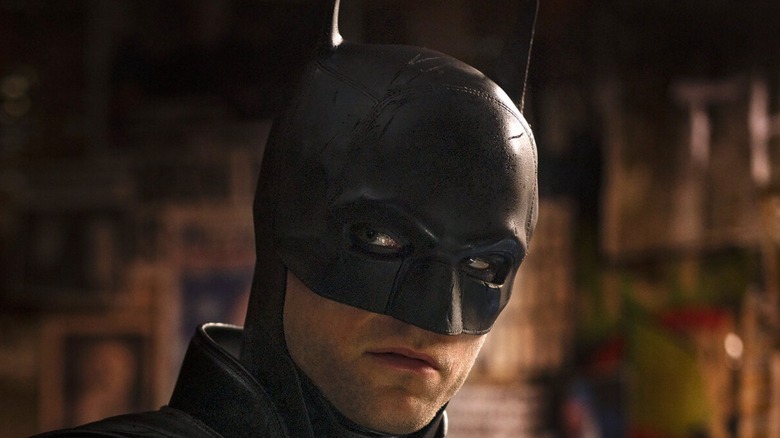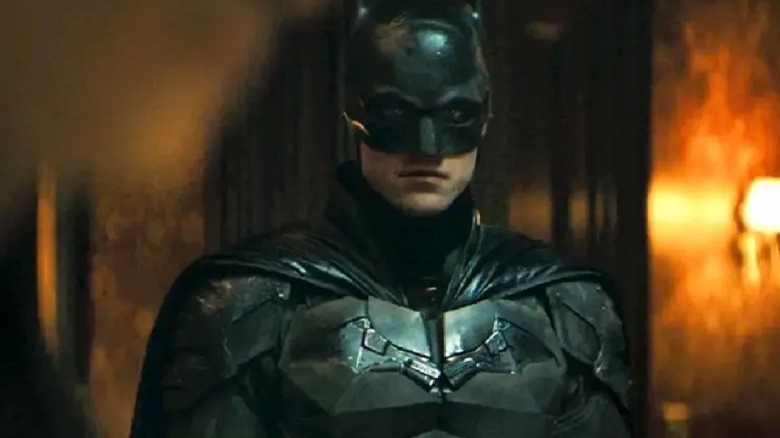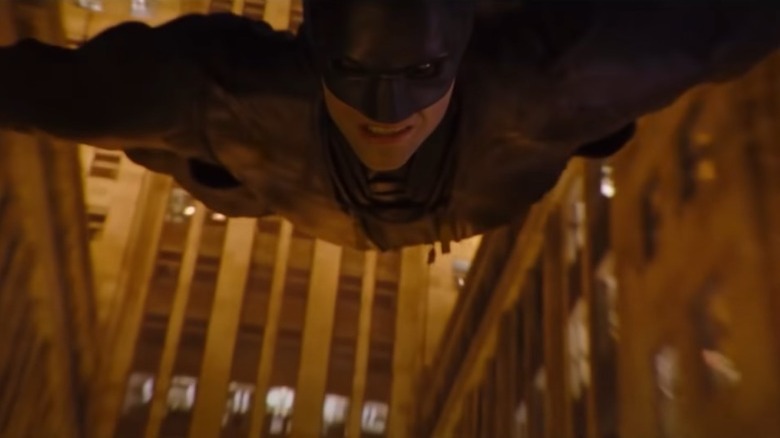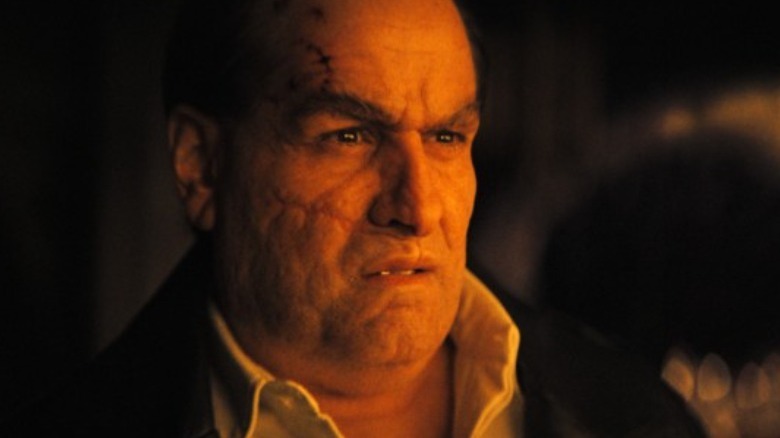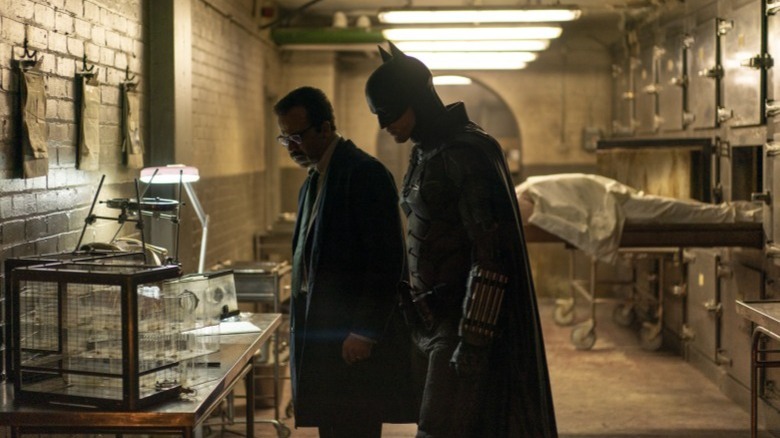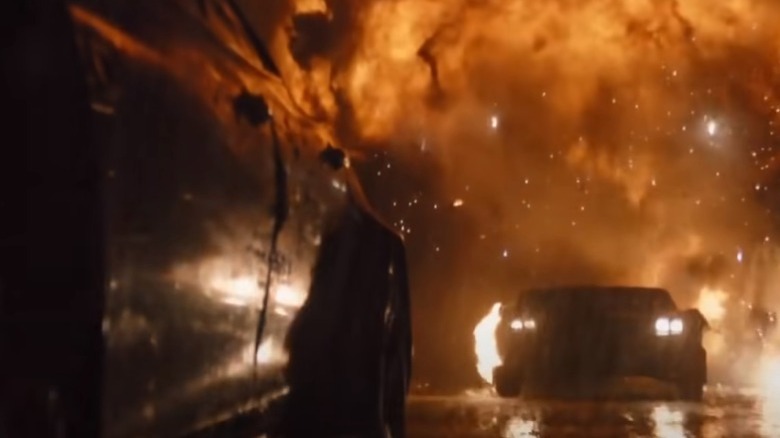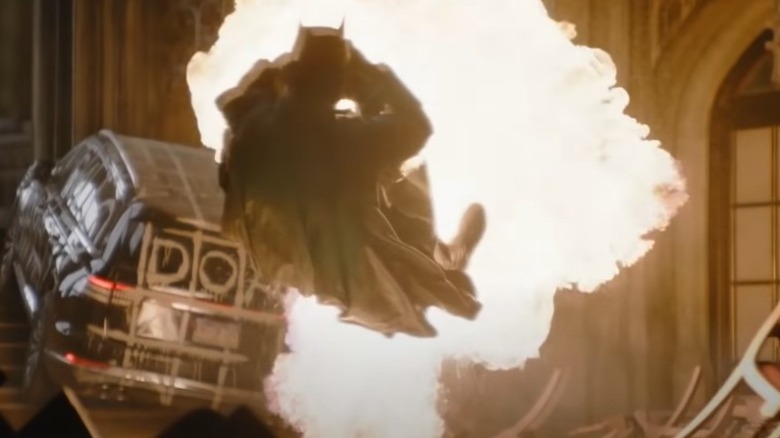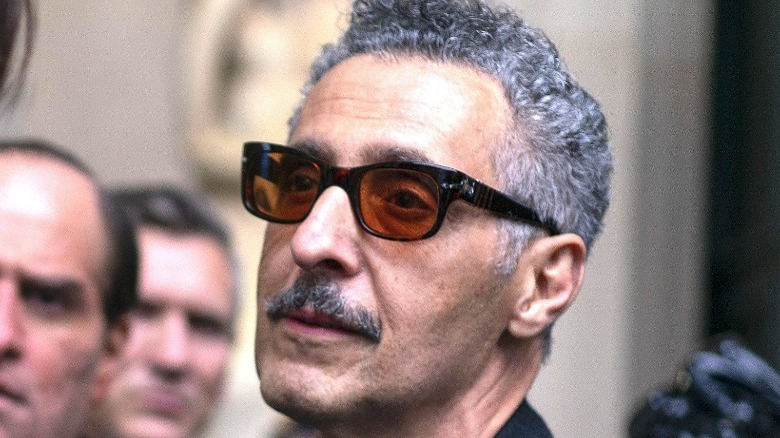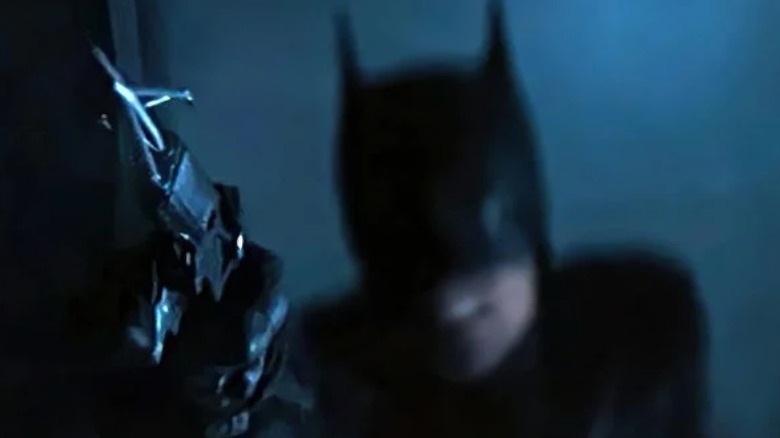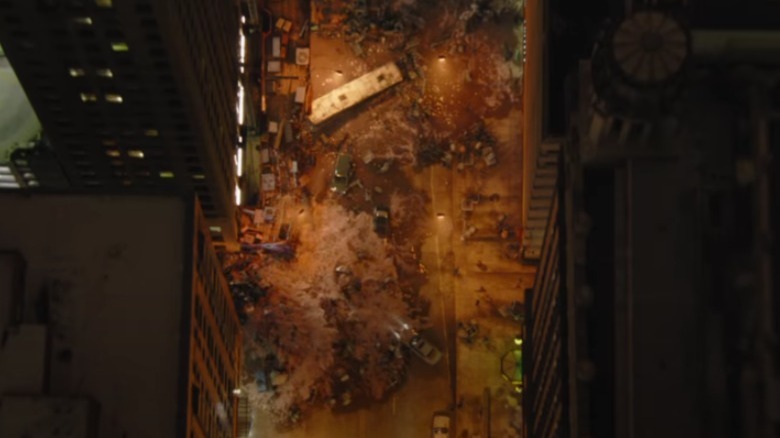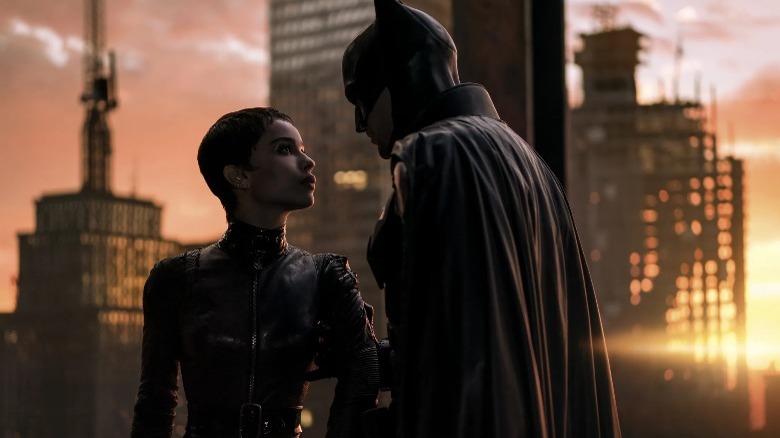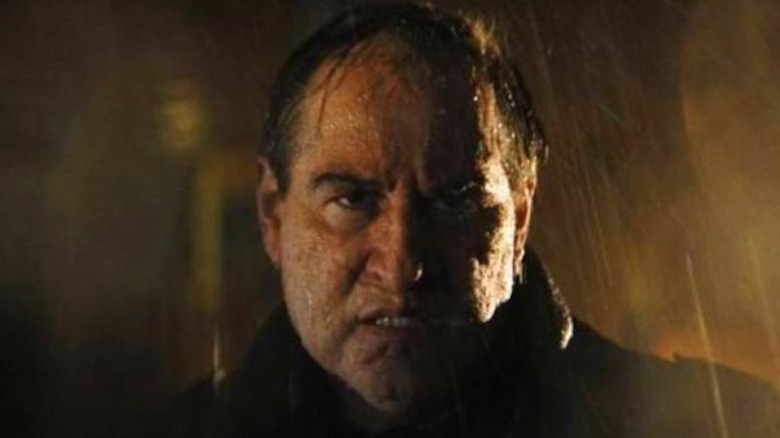Questionable Things We Ignore In The Batman
The Dark Knight strikes again with a fury befitting of the overall theme of vengeance in "The Batman." Director Matt Reeves weaves a tale of intrigue, mystery, horror, and thrills for newcomers and fans of the Bat alike to enjoy and discuss well into the future. Robert Pattinson's take on the character imbues the Caped Crusader with a steadfast stoicism and bitterness that leaves criminals quaking in their boots at the mere sight of the Bat-Signal. Meanwhile, the Riddler paints a bloody portrait of Gotham that unveils the city's deepest, darkest secrets and murders those responsible for taking part in them. Both the villain and hero of this story are fueled by their own hatred for the corrupt, and it's only after Batman realizes this twisted mirror image exists that he begins elevating his crusade beyond his own drive for vengeance.
"The Batman," like most superhero films, portrays a hero in desperate need of self-reflection and evolution. The film depicts Batman's world beginning to open up as he explores the dynamic between himself and his opponent as well as the first new human connection he's shared in two years with Selina Kyle. There's a lot to love about the latest depiction of everyone's favorite night-prowling and heroic vigilante. However, despite a seemingly straightforward narrative, the film contains several questionable moments that we might simply have to ignore for the sake of escapism. Let's examine the most confounding moments in "The Batman."
Warning: this article contains spoilers for "The Batman."
Batman's armor is overpowered
As the smog settles across the skyline of Gotham, the caped vigilante moves unseen across rooftops and through darkened alleys as he scours the streets for the unrepentant. While he's got skills, he's no expert ... at least not yet. In this film, Batman is an amateur compared to the character's usual depictions, which place him at the prime of his career. As a result, he's going to make mistakes. However, catching a bullet is potentially a mistake he won't walk away from, so Batman needs armor and protection from the weaponry of the criminals who stalk the streets. There is certainly no argument there, but what level of protection seems practical?
"The Batman" depicts a Dark Knight who boldly walks into public view at the Iceberg Lounge, surrounded by crooks and scum in every corner. While bold, it could draw overwhelming hostilities. Later in the film, Batman casually walks toward enemies who lay down heavy automatic weapon fire before he puts the hurt on them. Bullets ricochet off of him as if he was Kryptonian, and he even takes the full force of a shotgun blast to his chest and high-caliber rounds from sniper fire. Kevlar can only do so much, so whatever sturdy armor Batman's suit is made of seems to be quite miraculous.
Batman's landing from the wingsuit looks fatal
Bruce Wayne has built himself up to take a beating, and he's also got that magical armor to aid in his defense. However, taking a hit from the bad guys isn't always the biggest threat he faces. As Batman learns how to traverse the city quickly by utilizing his tools, there are going to be struggles with that pesky force we call gravity. Throughout Batman's career in comic books, television, and previous films, the Caped Crusader has been known to glide in order to quickly reach a destination.
At one point in "The Batman," he must find a speedy exit from the entirety of the police force, and he does so by taking flight with the wingsuit that emerges from his Batsuit. In keeping with traditional science claims about Batman's uncanny ability to avoid becoming a human smear on the ground after landing from a sustained glide, he deploys a parachute to slow down. Only this time, the parachute catches a bridge and slams the hero into a vehicle before he hits the concrete. Visually, the crash landing is rather jarring and looks to be quite painful. At a minimum, the Dark Knight should have a concussion. Yet somehow, he manages to hobble away and is quickly no worse for wear.
The Penguin never tips off Falcone
While there are crooks aplenty in the world of Gotham City, Carmine Falcone seems to run the show. Even Oz (aka the Penguin) is under the thumb of Falcone. Despite this, Oz is still blunt and bullish. It's clear that he has his own agenda, and as the owner and operator of the Iceberg Lounge, he gets around as far as the criminal underbelly of Gotham City is concerned. As the Riddler advances his campaign against Gotham's corrupt, he leads Batman to track down the one who ratted on Sal Maroni's operations; Batman and Jim Gordon begin to suspect Oz of being the rat.
Batman's pursuit of the Penguin results in a thrilling high-speed chase that leaves a trail of destruction in its wake (we'll tackle that shortly). Regardless, he catches up with the Penguin and interrogates him. Quickly, Batman and Gordon both realize that the Penguin isn't who they're looking for. However, knowing that the Dark Knight and the police are eyeing the mob, it's a wonder that Oz didn't run back to the Iceberg Lounge (or wherever Falcone is skulking around) and tip him off that they're being investigated.
Batman's no-guns rule
Famously, Batman has a no-guns rule in effect. Mostly, it's because of their tendency to inflict lethal force — something Batman tries to avoid. Furthermore, it was a man with a gun who killed his parents and caused his own personal torment all these years. "The Batman" portrays a version of the Dark Knight who is enraged by criminality, and throughout a majority of the film, he's driven by his hatred of those who seek prey on others. Declaring himself vengeance is a statement — he's about to take great pleasure in brutalizing his opposition.
Christopher Nolan's trilogy depicts a Bruce Wayne who had moved past his hatred by the time he became Batman. He once sought to kill his parents' murderer, but no longer — Bruce wants to become a symbol for Gotham, one that instills fear in criminals and brings hope to the innocent. In "The Batman," however, Bruce hasn't moved past his hatred, at least not until the third act. With this in mind, Batman asking Jim Gordon to holster his weapon doesn't seem to line up with the hero's current attitudes. Of course, he doesn't want to kill others himself because that'd only draw police attention, and, understandably, that's a line Batman doesn't want to cross personally. But his request for a police lieutenant to remove his firearm seems a bit out of place.
The Penguin faces no repercussions for the freeway incident
Everybody loves a thrilling chase sequence, and "The Batman" doesn't disappoint. Batman shows us just what his monstrous hot rod is capable of when he pursues the Penguin in a chase sequence for the ages. Either foolishly or in a calculated move, Oz steers into oncoming traffic on the freeway in a harrowing scene as the grimy gangster and the Dark Knight both dodge oncoming vehicles. But Oz knows that he's not going to shake his pursuer without drastic measure, so he causes a massive multi-car pile-up that involves a semi-truck carrying liquid fuel. The trailer explodes in a fiery blaze, but Batman finds a ramp in the wreckage to help him jump through the flames and take down the Penguin. Seeing the Batmobile streaking wildly out of the fire is a scene ripped right out of a "Fast & Furious" film.
The Dark Knight rips the Penguin out of his car, and both Jim Gordon and Batman interrogate him over his knowledge of the mob's operations. Strangely, he's never held accountable for his actions on the freeway. Oz causes massive devastation and likely kills several innocents in the big explosion, yet neither Batman or Jim Gordon presses the issue. When the pair follows a new lead, they abandon Penguin, albeit still tied up. It's an odd omission that's a bit puzzling.
Batman is largely unscathed by the Riddler's bomb
The Riddler wants to be seen. In "The Batman," he's making a statement, as are most serial-killing crusaders. However, the Riddler wants Gotham to feel his anger in all that he does, and Batman understands this to a degree. After the mayor and incumbent candidate for reelection is murdered by the Riddler in his own home, the city holds a funeral for the fallen leader. With a seemingly massive crowd that includes countless city officials as well as the mayor's rival in the campaign, what better place is there to strike another blow at Gotham's corruption? The Riddler sends the district attorney, Gil Colson, barreling into the chapel inside of a vehicle with a bomb strapped to his neck.
Bruce Wayne retreats and returns as Batman in an effort to approach the Riddler via phone and gain a better understanding of what he is after. The Riddler ultimately gives the corrupt district attorney a chance to solve three riddles and secure his safety, which Batman assists him with. But the third riddle is a question that Colson refuses to answer, thereby triggering the bomb. Batman is standing right in front of the city official when the bomb goes off, sending the Dark Knight flying backward and falling unconscious; he later awakens in the police precinct. Curiously, rendering Batman unconscious is rather tame for how close he was to the explosion. Even if Batman's magical armor protected him, he still has half a face exposed to burn damage. Nevertheless, Bruce manages to keep that rigid jawline intact without a scratch.
Why does the Riddler wait to take out Falcone?
Falcone ultimately has another thing coming, though the Riddler seemingly lets him walk freely and think he's untouchable for some time. Falcone is at the center of Gotham's corrupt leadership, paying off much of the police force, judges, and political leaders who help foster his sense of invincibility. While the Riddler sends Batman and Gordon on a wild goose chase to track down the "rat," the Riddler knows all along that it's Falcone.
At the mayor's funeral, Falcone is present, and the Riddler has every opportunity to kill him at this event. He could've even extorted Gil Colson to get close to the mobster in order to take him out in the explosion. Of course, there's obviously a certain level of craftsmanship in the Riddler's work. Perhaps, for the sake of order and spectacle, he bided his time. Still, it's still a mystery why he allows Falcone to draw breath for as long as he does.
Where does Batman obtain his tech?
Batman is always outfitted with the best of the best. His extensive wealth affords him the quality gear he needs and the advanced technologies he employs to combat crime on the streets. In most iterations of the character, he has tech most ordinary people have never even heard of. In Batman lore, the Caped Crusader has a partnership with Lucius Fox — typically seen as the CEO of Wayne Industries — who procures the gadgetry Batman needs in the field. Often, he commissions the development of brand-new pieces of hardware uniquely for the Batman. The "Dark Knight" trilogy establishes this with Morgan Freeman in the role of Lucius Fox.
However, "The Batman" doesn't introduce us to a Lucius Fox. Sure, the Batmobile certainly looks like a vehicle a wealthy but reclusive billionaire could have constructed on his own, but Bruce is hardly a tech developer. So, it begs the question: Where did he obtain some of his most notable gadgets, like the contact lenses that allow him to stream and record everything he sees? Bruce or Alfred must have connections in this world that we aren't aware of, as it's unlikely that the pair developed this gear on their own.
Why does the Riddler shift gears and kill innocents in the third act?
The Riddler's mission is to kill and expose Gotham's worst crooks. Seemingly, it's not just a mission of revenge, but one of betterment for the city (although serial killing may not be the ideal way to go about it). However, the Riddler was one of the innocents in Gotham plagued by the rampant of greed of corporate and political bureaucrats that siphoned away all the funding designed to renew the city in an effort to fatten their own bank accounts. As such, the Riddler isn't after just anyone in particular — the bodies he leaves in his wake are criminals who have destroyed lives.
While it's apparent that the Riddler may have a few screws loose, his endgame plan is city-wide destruction as he destroys the walls of a reservoir, causing mass flooding and chaos in the streets of Gotham. His followers aim to kill the remaining mayoral candidate and also rain down bullets on the innocent in a scene horrifically reminiscent of modern-day atrocities. It's an odd turn for the villain and one that doesn't feel earned. In fact, it's questionable at best because the Riddler turns against those who might be just like him.
Batman never resolves Selina Kyle's interference with the Penguin
The Riddler leads Batman and the entire police force on a wild goose chase with each clue. Eventually, he references the rat that sold out Maroni's operations, and the Dark Knight and Gordon believe that man is the Penguin. They plan to question him, and when they attempt to ambush the crook, they find Selina Kyle at the scene, stealing from him. She ultimately foils the entire plan as the Penguin spots the pair talking and opens fire on them. Of course, Batman saddles up on his trusty steed made of steel, nuts, and bolts and burns rubber chasing after the Penguin in an explosive highway chase sequence.
The big mystery here is that Batman never confronts Selina over the botched sting afterward. Not only that, but the pair already share a deeper connection at this point, so it's a wonder that he didn't discuss the theft, her missing friend, or the potential danger she placed them in. Though in her defense, Selina Kyle is more than capable of handling herself, and Batman is starting to realize it.
Everyone forgets that the Penguin intended to kill Falcone in front of police officers
All roads lead to Carmine Falcone as the big rat all along. Meanwhile, Selina is chomping at the bit to kill her own father for his involvement in killing her friend. She is disgusted by her father's career and almost kills him before Batman stops her. Falcone is then arrested, and as the police are escorting him out of the building, the Penguin becomes angered by the new knowledge that Falcone was the rat. He even points a gun at Falcone while in police custody, fully intending to kill him. A shot rings out, and Falcone hits the ground, but it's not from the Penguin's gun — the Riddler beat him to the punch, sniping the gangster from a nearby building.
Of course, the police and Batman pursue the most important lead at the moment — the shadowy figure fleeing the scene from the apartment window. They locate the Riddler's apartment and find him helping himself to some coffee at the diner down the street. Everything is about the Riddler, but it seems like both Batman and the police are so enamored with the villain that they are once again at peace with forgetting about the Penguin's criminal acts. Remember: A man was being walked away in handcuffs by police and the Penguin pointed a gun at him with countless witnesses. It's an odd moment to forget alongside the Penguin's trail of destruction on the highway.
